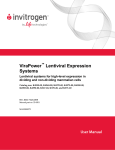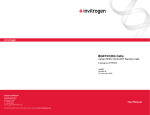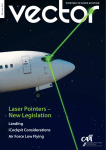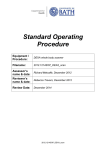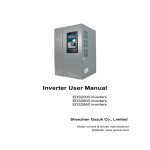Download Subculturing Cells
Transcript
Growth and Maintenance of the 293FT Cell Line Catalog nos. R700-07 Rev. Date: 14 July 2010 Manual part no. 25-0504 MAN0000276 User Manual ii Table of Contents Contents and Storage ........................................................................................................................................... v Accessory Products.............................................................................................................................................. vi Introduction ................................................................................................................... 1 Product Information ..............................................................................................................................................1 Methods ......................................................................................................................... 2 General Information ..............................................................................................................................................2 Thawing Cells.........................................................................................................................................................4 Subculturing Cells .................................................................................................................................................5 Freezing Cells .........................................................................................................................................................7 Transfecting Cells ..................................................................................................................................................8 Appendix........................................................................................................................ 9 Map of pCMVSPORT6TAg.neo...........................................................................................................................9 Technical Support ................................................................................................................................................10 Purchaser Notification ........................................................................................................................................11 References .............................................................................................................................................................12 iii iv Contents and Storage 293FT Cell Line The 293FT Cell Line is used for the production of lentiviral stocks. The 293FT Cell Line is supplied as one vial containing 3 x 106 frozen cells in 1 ml of Freezing Medium. Upon receipt, store in liquid nitrogen until use. Handle as potentially biohazardous material under at least Biosafety Level 2 containment. This product contains Dimethyl Sulfoxide (DMSO), a hazardous material. Review the Material Safety Data Sheet before handling. v Accessory Products Accessory Products The products listed below may be used with the 293FT Cell Line. For more information, refer to our Web site (www.invitrogen.com) or call Technical Support (see page 10). Note: Some reagents are available in other sizes. Item ™ Lipofectamine 2000 Reagent Catalog no. 0.75 ml 11668-027 1.5 ml 11668-019 Dulbecco’s Modified Eagle Medium (D-MEM) 500 ml 11965-092 1000 ml 11965-084 Fetal Bovine Serum 100 ml 16000-036 500 ml 16000-044 10 mM MEM Non-Essential Amino Acids 100 ml Solution 11140-050 200 mM L-Glutamine 100 ml 25030-081 MEM Sodium Pyruvate Solution (100X) 100 ml 11360-070 Penicillin-Streptomycin 100 ml 15070-063 Trypsin-EDTA 100 ml 25300-054 1g 11811-023 5g 11811-031 20 ml (50 mg/ml) 10131-035 100 ml (50 mg/ml) 10131-027 100 ml 31985-062 500 ml 31985-070 500 ml 10010-023 1L 10010-031 100 ml 15250-061 ® Geneticin Selective Antibiotic Opti-MEM® I Reduced Serum Medium Phosphate-Buffered Saline (PBS), pH 7.4 Trypan Blue Stain vi Amount Introduction Product Information 293FT Cell Line The 293FT Cell Line is a very suitable host for lentiviral production. The 293FT Cell Line is derived from the 293F Cell Line (see below) and stably expresses the SV40 large T antigen from the pCMVSPORT6TAg.neo plasmid. Expression of the SV40 large T antigen is controlled by the human cytomegalo-virus (CMV) promoter and is high-level and constitutive. For more information about pCMVSPORT6TAg.neo, see the Appendix, page 9. Use of the Cell Line Studies have demonstrated maximal virus production in human 293 cells expressing SV40 large T antigen (Naldini et al., 1996), making the 293FT Cell Line a particularly suitable host for generating lentiviral constructs using the ViraPower™ Lentiviral Expression System available from Invitrogen (Catalog nos. K4950-00 and K4960-00). Parental Cell Lines The 293 Cell Line is a permanent line established from primary embryonal human kidney transformed with sheared human adenovirus type 5 DNA (Graham et al., 1977; Harrison et al., 1977). The E1A adenovirus gene is expressed in these cells and participates in transactivation of some viral promoters, allowing these cells to produce very high levels of protein. The 293-F Cell Line available from Invitrogen (Catalog no. 11625) is a fastgrowing variant of the 293 cell line, and was originally obtained from Robert Horlick at Pharmacopeia. Antibiotic Resistance 293FT cells stably express the neomycin resistance gene from pCMVSPORT6TAg.neo and should be maintained in medium containing Geneticin® at the concentration listed below. Expression of the neomycin resistance gene in 293FT cells is controlled by the SV40 enhancer/promoter. 1 Methods General Information General Cell Handling Before Starting Follow the general guidelines below to grow and maintain 293FT cells. Make sure that all solutions and equipment that come in contact with the cells are sterile. Always use proper sterile technique and work in a laminar flow hood. Before starting experiments, be sure to have cells established and also have some frozen stocks on hand. We recommend using early-passage cells for your experiments. For general maintenance of cells, pass 293FT cells when they are > 80% confluent. Avoid overgrowing cells before passaging. Maintain 293FT cells in complete medium containing 500 g/ml Geneticin®. Use trypan blue exclusion to determine cell viability. Log phase cultures should be >90% viable. When thawing or subculturing cells, transfer cells into medium warmed to room temperature. Cells should be at the appropriate confluence and at greater than 90% viability prior to transfection (see page 8). Be sure to have the following solutions and supplies available: 15 ml sterile, conical tubes Appropriate sized tissue culture flasks and pipettes Complete medium (see page 3) 50 mg/ml Geneticin® Phosphate-Buffered Saline (PBS; Invitrogen, Catalog no. 10010-023) Reagents for counting cells Trypsin/versene (EDTA) solution or other trypsin solution Freezing Medium (see pages 3 and 7) Table-top centrifuge Cryovials (if needed) Continued on next page 2 General Information, continued Media for 293FT Cells The table below lists the recommended complete medium, freezing medium, and antibiotic concentration required to maintain and culture the 293FT Cell Line. Note: Fetal bovine serum should not be heat-inactivated for use with the 293FT Cell Line. Complete Medium D-MEM (high glucose) 10% fetal bovine serum (FBS) [Antibiotic] 500 g/ml Geneticin® Freezing Medium 90% complete medium 10% DMSO 0.1 mM MEM Non-Essential Amino Acids (NEAA) 6 mM L-glutamine 1 mM MEM Sodium Pyruvate 1% Pen-Strep (optional) D-MEM already contains 4 mM L-glutamine, which is enough to support cell growth of the 293FT Cell Line. However, since L-glutamine slowly decays over time, the complete medium needs to be supplemented with 2 mM L-glutamine. This will ensure that the concentration of L-glutamine in complete medium will not get too low over time due to its slow degradation. Note: 293FT cells grow well in 6 mM L-glutamine, but higher concentrations of Lglutamine may reduce growth. Preparing Medium Prepare the complete D-MEM medium containing 10% FBS supplemented with 0.1 mM MEM Non-Essential Amino Acids, 1 mM sodium pyruvate and 2 mM Lglutamine as described below using reagents Perform all steps in a tissue culture hood under sterile conditions. 1. Remove 100 ml D-MEM from 1 L D-MEM bottle and replace with 100 ml FBS. 2. To the bottle of medium, add the following: 200 mM L-Glutamine (100X) 10 mM MEM Non-Essential Amino Acids (100X) 100 mM MEM Sodium Pyruvate (100X) Optional: Penicillin-Streptomycin (100X) 10 ml 10 ml 10 ml 10 ml 3. Filter sterilize the medium using 0.45 m filtration device. 4. Store the complete medium at 4C until use. The medium is stable for 6 months at 4C (avoid introducing any contamination into the medium). 5. To an aliquot of the complete medium, add Geneticin® to prepare complete medium with 500 μg/ml Geneticin®. 3 Thawing Cells Introduction The 293FT Cell Line is supplied in a vial containing 3 x 106 cells in 1 ml of Freezing Medium. Store frozen 293FT cells in liquid nitrogen until ready to use. Handle as potentially biohazardous material under at least Biosafety Level 2 containment. This product contains Dimethyl Sulfoxide (DMSO), a hazardous material. Review the Material Safety Data Sheet before handling. 4 Use the following procedure to thaw 293FT cells to initiate cell culture. Thaw cells in prewarmed, complete medium without Geneticin®. 1. Remove the vial of frozen cells from liquid nitrogen and thaw quickly in a 37°C water bath. 2. Just before the cells are completely thawed, decontaminate the outside of the vial with 70% ethanol, and transfer the cells to a sterile 15 ml tube containing PBS. Briefly centrifuge the cells at 150-200 x g and resuspend the cells in 2 ml complete medium without Geneticin®. 3. Transfer the cells to T-75 cm2 flask containing 10 ml of complete medium without Geneticin®. 4. Incubate the flask overnight at 37°C for allowing the cells to attach to the bottom of the flask. 5. The next day, aspirate off the medium and replace with fresh, complete medium containing 500 g/ml Geneticin®. 6. Incubate the cells and check them daily until the cells are 80-90% confluent. 7. Proceed to Subculturing Cells, next page. MEND ION AT RECOM Thawing Cells We recommend subculturing cells for a minimum of 3 passages after thawing before use in other applications. Subculturing Cells Introduction Follow the recommendations and procedures in this section to subculture 293FT cells. Maintain cells as adherent monolayer cultures in complete medium containing 500 g/ml Geneticin®. Subculturing Conditions Use the following recommended conditions to subculture 293FT cells. For a procedure to subculture cells, see below. Parameter Determining Viability and Cell Density Recommended Condition 5 Cell density > 5 x 10 viable cells/ml (> 80% confluent) Culture vessel T-75 cm2 to T-162 cm2 disposable sterile T-flasks. Dilute cells in a total working volume of 15-20 ml for T-75 cm2 flasks and 40-50 ml for T-162 cm2 flasks Seeding density 2 to 5 x 104 viable cells/cm2 Incubation conditions 37C incubator with a humidified atmosphere of 5-10% CO2 in air; loosen caps to allow for oxygenation/aeration Follow the procedure below to determine viable and total cell counts using the trypan blue exclusion method. 1. Transfer a small aliquot of the cell suspension to a microcentrifuge tube and dilute the cells such that the total number of cells counted will not be less than 100 or more than 1,000. 2. To 1 ml of the diluted cell suspension, add 100 μl Trypan Blue Stain (0.4%) solution. Gently aspirate to mix. 3. Record the dilution factor. The dilution factor equals the total volume (amount of cell suspension and amount of trypan blue) divided by the amount of cell suspension. 4. Incubate the cells with the trypan blue solution for 1-2 minutes. 5. Count all cells (including the blue cells) using a Coulter Counter or manually using a hemocytometer chamber. 6. To calculate the total cells per ml in suspension, multiply the total count by the dilution factor. 7. To determine the viability, count only the blue cells. Calculate the % viability: [1.00 - (Number of blue cells ÷ Number of total cells)] x 100 8. Cell viability should be at least 95% for healthy log-phase cultures. Continued on next page 5 Subculturing Cells, continued Subculturing Cells Use this procedure to subculture 293FT cells grown in a T-75 cm2 flask. If you are using other-sized flasks, scale the reagent volumes accordingly. 6 1. Remove all medium from the flask and wash the cells once with 10 ml PBS to remove excess medium and serum. Serum contains inhibitors of trypsin. 2. Add 2 ml of trypsin/versene (EDTA) solution to the monolayer and incubate 1-5 minutes at room temperature until cells detach. Check the cells under a microscope and confirm that most of the cells have detached. If cells are still attached, incubate a little longer until most of the cells have detached. 3. Add 8 ml complete medium containing Geneticin® and transfer the cell suspension to a 15 ml sterile, conical tube. 4. Determine viable and total cell counts (see procedure above). 5. Seed cells at the recommended density (see table on previous page), diluting in pre-warmed complete medium containing 500 g/ml Geneticin®. Incubate flasks as recommended (see table on previous page). 6. Maintain cells as adherent monolayer cultures in complete medium containing 500 g/ml Geneticin®. 7. For the transfection protocol, you will need 6 x 106 293FT cells for each sample (page 8). Freezing Cells Introduction Freezing Cells Once you have established the cells, we recommend freezing some cells for future use as described below. Freeze cells at a density of at least 3 x 106 viable cells/ml. Use a freezing medium composed of 90% complete medium and 10% DMSO. Prepare freezing medium immediately before use. Filter-sterilize the freezing medium and store at +4C until use. Discard any remaining freezing medium after use. Before starting, label cryovials and prepare freezing medium (see above). Keep the freezing medium on ice. 1. Culture the desired quantity of 293FT cells to 70-90% confluency. 2. Remove the cells from the tissue culture flask(s) following Steps 1-3, Subculturing Cells, page 6. 3. Determine viable and total cell counts (see procedure on page 5) and calculate the volume of freezing medium required to yield a final cell density of 3 x 106 cells/ml. 4. Prepare the required volume of freezing medium (see above). 5. Centrifuge the cells suspension (from Step 2) at 250 x g for 5 minutes in a table top centrifuge at room temperature. Carefully aspirate off the medium and resuspend the cell pellet in the pre-determined volume of chilled freezing medium. 6. Dispense aliquots of this suspension (frequently mixing to maintain a homogeneous cell suspension) into cryovials according to manufacturer’s specifications. 7. Freeze cells in an automated, controlled-rate freezing apparatus or using a manual method following standard procedures. For ideal cryopreservation, the freezing rate should be a decrease of 1°C per minute. 8. Transfer vials to liquid nitrogen storage. Note: You may check the viability and recovery of frozen cells 24 hours after storing cryovials in liquid nitrogen by following the procedure outlined in Thawing Cells, page 4. 7 Transfecting Cells Transfection Methods The 293FT Cell Line is generally amenable to transfection using standard methods including calcium phosphate precipitation (Chen & Okayama, 1987; Wigler et al., 1977), lipid-mediated transfection (Felgner et al., 1989; Felgner & Ringold, 1989), and electroporation (Chu et al., 1987; Shigekawa & Dower, 1988). We typically use cationic lipid-based transfection reagents to transfect 293FT cells. Lipofectamine™ 2000 is recommended, but other transfection reagents are suitable. Lipofectamine™ 2000 is available from Invitrogen (see page vi for ordering information). Transient Transfection The 293FT Cell Line may be transiently transfected with any plasmid. General guidelines are provided below. Generating Stable Cell Lines Make sure that cells are healthy at the time of plating. Overgrowth of cells prior to passaging can compromise their transfection efficiency. On the day before transfection, plate cells such that they will be at the appropriate confluence at the time of transfection (see manufacturer’s recommendations for the transfection reagent you are using). Example: If you are using Lipofectamine™ 2000 as a transfection reagent, plate cells such that they will be 90-95% confluent at the time of transfection. Transfect your plasmid construct into the 293FT Cell Line using the method of choice (see above). After transfection, add fresh growth medium containing 500 g/ml Geneticin® and allow the cells to recover for 24-48 hours before proceeding to assay for expression of your gene of interest. 293FT cells can be used as hosts to generate a stable cell line expressing your gene of interest from most plasmids (see Note below). Remember that the introduced plasmid must contain a selection marker other than neomycin resistance. Stable cell lines can then be generated by transfection and dual selection with Geneticin® and the appropriate selection agent. Since 293FT cells stably express the SV40 large T antigen, we do not recommend generating stable cell lines with plasmids that contain the SV40 origin of replication. 8 Appendix Map of pCMVSPORT6TAg.neo The pCMVSPORT6TAg.neo plasmid is derived from pCMVSPORT6, which has been modified to include the following features: The neomycin resistance gene for stable selection in mammalian cells (Southern & Berg, 1982). Expression of the neomycin resistance gene is controlled by the SV40 early enhancer/promoter from which the SV40 origin of replication has been removed. The gene encoding the SV40 large T antigen to facilitate optimal virus production (e.g. Invitrogen’s ViraPower™ Lentiviral Expression System) and to permit episomal replication of plasmids containing the SV40 early promoter and origin. Expression of the SV40 large T antigen is controlled by the human cytomegalovirus (CMV) promoter. P pA SV40 T7 40 SV T Lg Neom yci n Am 6 pA pCMVSPORT6TAg.neo 8645 bp pi ci SP Description lli n p U C o ri P CM V 9 Technical Support Web Resources Contact Us Visit the Invitrogen website at www.invitrogen.com for: Technical resources, including manuals, vector maps and sequences, application notes, SDSs, FAQs, formulations, citations, handbooks, etc. Complete technical support contact information Access to the Invitrogen Online Catalog Additional product information and special offers For more information or technical assistance, call, write, fax, or email. Additional international offices are listed on our website (www.invitrogen.com). Corporate Headquarters: 5791 Van Allen Way Carlsbad, CA 92008 USA Tel: 1 760 603 7200 Tel (Toll Free): 1 800 955 6288 Fax: 1 760 602 6500 E-mail: [email protected] Japanese Headquarters: LOOP-X Bldg. 6F 3-9-15, Kaigan Minato-ku, Tokyo 108-0022 Tel: 81 3 5730 6509 Fax: 81 3 5730 6519 E-mail: [email protected] European Headquarters: Inchinnan Business Park 3 Fountain Drive Paisley PA4 9RF, UK Tel: +44 (0) 141 814 6100 Tech Fax: +44 (0) 141 814 6117 E-mail: [email protected] SDS Safety Data Sheets (SDSs) are available at www.invitrogen.com/sds. Certificate of Analysis The Certificate of Analysis provides detailed quality control and product qualification information for each product. Certificates of Analysis are available on our website. Go to www.invitrogen.com/support and search for the Certificate of Analysis by product lot number, which is printed on the box. Limited Warranty Invitrogen (a part of Life Technologies Corporation) is committed to providing our customers with high-quality goods and services. Our goal is to ensure that every customer is 100% satisfied with our products and our service. If you should have any questions or concerns about an Invitrogen product or service, contact our Technical Support Representatives. All Invitrogen products are warranted to perform according to specifications stated on the certificate of analysis. The Company will replace, free of charge, any product that does not meet those specifications. This warranty limits the Company’s liability to only the price of the product. No warranty is granted for products beyond their listed expiration date. No warranty is applicable unless all product components are stored in accordance with instructions. The Company reserves the right to select the method(s) used to analyze a product unless the Company agrees to a specified method in writing prior to acceptance of the order. Invitrogen makes every effort to ensure the accuracy of its publications, but realizes that the occasional typographical or other error is inevitable. Therefore the Company makes no warranty of any kind regarding the contents of any publications or documentation. If you discover an error in any of our publications, report it to our Technical Support Representatives. Life Technologies Corporation shall have no responsibility or liability for any special, incidental, indirect or consequential loss or damage whatsoever. The above limited warranty is sole and exclusive. No other warranty is made, whether expressed or implied, including any warranty of merchantability or fitness for a particular purpose. 10 Purchaser Notification Introduction Use of the 293FT Cell Line is covered under the licenses detailed below. Information for European Customers The 293FT Cell Line is genetically modified and carries the pUC-derived plasmid, pCMVSPORT6TAg.neo. As a condition of sale, use of this product must be in accordance with all applicable local legislation and guidelines including EC Directive 90/219/EEC on the contained use of genetically modified organisms. Limited Use Label License No. 5: Invitrogen Technology The purchase of this product conveys to the buyer the non-transferable right to use the purchased amount of the product and components of the product in research conducted by the buyer (whether the buyer is an academic or for-profit entity). The buyer cannot sell or otherwise transfer (a) this product (b) its components or (c) materials made using this product or its components to a third party or otherwise use this product or its components or materials made using this product or its components for Commercial Purposes. The buyer may transfer information or materials made through the use of this product to a scientific collaborator, provided that such transfer is not for any Commercial Purpose, and that such collaborator agrees in writing (a) not to transfer such materials to any third party, and (b) to use such transferred materials and/or information solely for research and not for Commercial Purposes. Commercial Purposes means any activity by a party for consideration and may include, but is not limited to: (1) use of the product or its components in manufacturing; (2) use of the product or its components to provide a service, information, or data; (3) use of the product or its components for therapeutic, diagnostic or prophylactic purposes; or (4) resale of the product or its components, whether or not such product or its components are resold for use in research. For products that are subject to multiple limited use label licenses, the terms of the most restrictive limited use label license shall control. Life Technologies Corporation will not assert a claim against the buyer of infringement of patents owned or controlled by Life Technologies Corporation which cover this product based upon the manufacture, use or sale of a therapeutic, clinical diagnostic, vaccine or prophylactic product developed in research by the buyer in which this product or its components was employed, provided that neither this product nor any of its components was used in the manufacture of such product. If the purchaser is not willing to accept the limitations of this limited use statement, Life Technologies is willing to accept return of the product with a full refund. For information about purchasing a license to use this product or the technology embedded in it for any use other than for research use please contact Out Licensing, Life Technologies, 5791 Van Allen Way, Carlsbad, California 92008; Phone (760) 603-7200 or e-mail: [email protected]. 11 References Chen, C., and Okayama, H. (1987) High-Efficiency Transformation of Mammalian Cells by Plasmid DNA. Mol. Cell. Biol. 7, 2745-2752 Chu, G., Hayakawa, H., and Berg, P. (1987) Electroporation for the Efficient Transfection of Mammalian Cells with DNA. Nucleic Acids Res. 15, 1311-1326 Felgner, P. L., Holm, M., and Chan, H. (1989) Cationic Liposome Mediated Transfection. Proc. West. Pharmacol. Soc. 32, 115-121 Felgner, P. L. a., and Ringold, G. M. (1989) Cationic Liposome-Mediated Transfection. Nature 337, 387388 Graham, F. L., Smiley, J., Russell, W. C., and Nairn, R. (1977) Characteristics of a Human Cell Line Transformed by DNA from Human Adenovirus Type 5. J. Gen. Virol. 36, 59-74 Harrison, T., Graham, F., and Williams, J. (1977) Host-range Mutants of Adenovirus Type 5 Defective for Growth in HeLa Cells. Virology 77, 319-329 Naldini, L., Blomer, U., Gage, F. H., Trono, D., and Verma, I. M. (1996) Efficient Transfer, Integration, and Sustained Long-Term Expression of the Transgene in Adult Rat Brains Injected with a Lentiviral Vector. Proc. Natl. Acad. Sci. USA 93, 11382-11388 Shigekawa, K., and Dower, W. J. (1988) Electroporation of Eukaryotes and Prokaryotes: A General Approach to the Introduction of Macromolecules into Cells. BioTechniques 6, 742-751 Southern, P. J., and Berg, P. (1982) Transformation of Mammalian Cells to Antibiotic Resistance with a Bacterial Gene Under Control of the SV40 Early Region Promoter. J. Molec. Appl. Gen. 1, 327-339 Wigler, M., Silverstein, S., Lee, L.-S., Pellicer, A., Cheng, Y.-C., and Axel, R. (1977) Transfer of Purified Herpes Virus Thymidine Kinase Gene to Cultured Mouse Cells. Cell 11, 223-232 ©2010 Life Technologies Corporation. All rights reserved. For research use only. Not intended for any animal or human therapeutic or diagnostic use. The trademarks mentioned herein are the property of Life Technologies Corporation or their respective owners. 12 Corporate Headquarters 5791 Van Allen Way Carlsbad, CA 92008 T: 1 760 603 7200 F: 1 760 602 6500 E: [email protected] For country-specific contact information, visit our web site at www.invitrogen.com






















